Essential resources for AI-enhanced drafting methods
Legal professionals are constantly seeking ways to maximize efficiency and profitability in today’s legal landscape, all while delivering exceptional service to their clients. However, a significant challenge persists: The time-consuming nature of legal drafting.
Law firms know this is an issue. Thomson Reuters legal customers have said that on average, they need to spend as much as 40% to 60% of their time drafting documents. 96% of those surveyed also believe that their drafting tools aren’t efficient enough.
Given the threat of non-traditional, low-cost legal service providers, lawyers are under growing pressure to draft more quickly and more cleanly, with fewer bottlenecks in the process. This would be a near-insurmountable task, given many firms’ current drafting tools. But using generative artificial intelligence (GenAI) powered tools can make next-generation legal drafting achievable today.
Jump to ↓
| How AI-powered legal drafting works |
| Benefits of AI in legal drafting |
| Considerations for selecting AI tools |
| Building the business case for AI tools |
| Implementing successful change management via GenAI tools |

White paper
AI-powered legal drafting: The definitive guide for legal professionals
Read white paper ↗How AI-powered legal drafting works
Traditional methods of legal drafting have lawyers beginning the process with a framework, using existing precedents such as parties’ names, signature clauses, and boilerplate sections to provide a rough shape for the contract. Lawyers then focus on operative clauses and identify any rights, permission, or ownership that emerge from the agreement. Throughout the process, they draft with potential risks in mind and use clear, unambiguous language in the contract.
While these steps remain crucial, GenAI tools power legal professionals through the drafting stage with speed and with greater efficiency. The time they save enables lawyers to devote more of their workload to providing value-added client services, such as advising on acquisition strategy.
Here are three ways GenAI-powered tools can elevate the drafting process:
Finding the right starting point
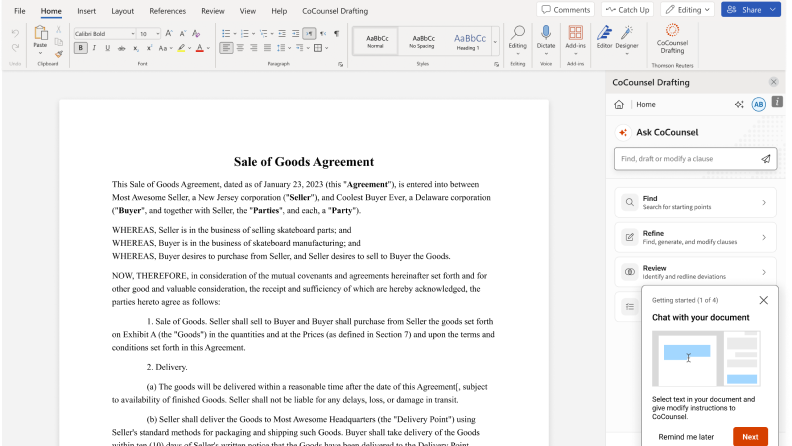
From veteran partners to just-hired associates, all lawyers can struggle to find the right place to begin a draft. It’s not something to take lightly, as choosing a poor launching point could derail the drafting process. If you have to abandon a draft and start from scratch — say, if you need to incorporate a clause you forgot to consider — that means delays.
AI-powered drafting tools give lawyers an array of possible starting points, based upon their work histories, preferences and specific requests.
Easy access to previous documents
A common lawyer headache: Reading a document, suddenly realizing that you need to make note of an important reference in another document that you’d previously read, then having to dig through files or run manual scans on databases to find the reference.
GenAI tools that employ natural language make this situation far easier. Now a lawyer can easily retrieve information from whichever source they need, whether it’s from one of their earlier drafts or a colleague’s document on file.
Greater consistency with legal playbooks
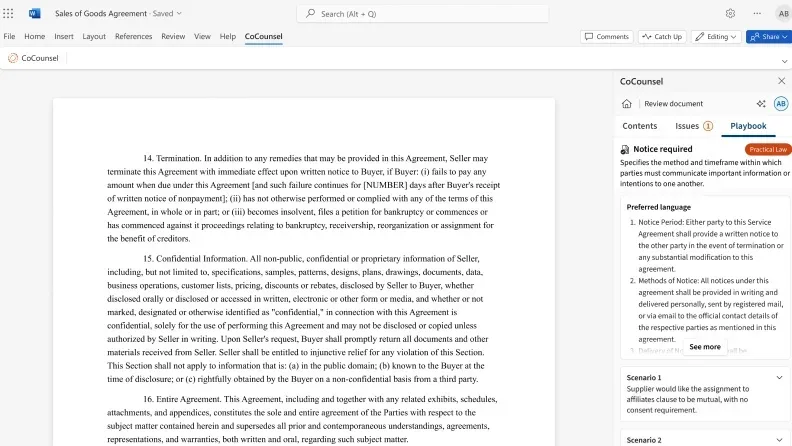
Junior lawyers often struggle to ensure their drafts are consistent with legal industry stylebooks, as well as their own firm’s parameters. They typically need a senior lawyer to review their work to make sure everything’s in order.
Now AI-powered tools enforce consistency while the initial draft is being written. Clause language gets automatically modified to the most up-to-date usage, if needed. Automated formatting functions also eliminate the need for a full formatting step in the drafting revision process.
Benefits of AI in legal drafting
GenAI can be a multi-pronged tool for lawyers — one that lets them quickly begin a draft, run ongoing analyses of all relevant documents while they work within Microsoft Word, and ensure that the draft adheres to industry standards.
Let’s say, for example, that a lawyer is asked to draft an employment agreement between a manufacturer and its new distributor. The lawyer begins by using GenAI to find the best starting template for the contract. They survey a number of templates for distribution agreements and choose the most relevant one. Upon this decision, the system automatically generates a new contract for the lawyer to fill in.
The lawyer can then have their system scan a variety of databases, searching for up-to-date clauses and terminology. They can also use a chat-based GenAI assistant to help them answer any essential questions that crop up during the course of drafting, such as:
- Which of the client’s requests will require getting permission from the other party or parties?
- What is the ownership status of any material being created?
- If either party in the contract is granting rights to the other, how will these be exercised?
As the initial draft is being generated, GenAI tools help to finesse it, noting where the language seems too vague and flagging any clauses or phrases that could be outdated.
Considerations for selecting AI tools
Given such potential benefits, law firms need to select the right AI-powered tool — a system that works for their business and is tailored to provide superior drafting assistance. They should assess a prospective tool’s capabilities, know where it draws its content from, have a good sense of its data security procedures, and be familiar with its process of error mitigation.
What are the tool’s capabilities?
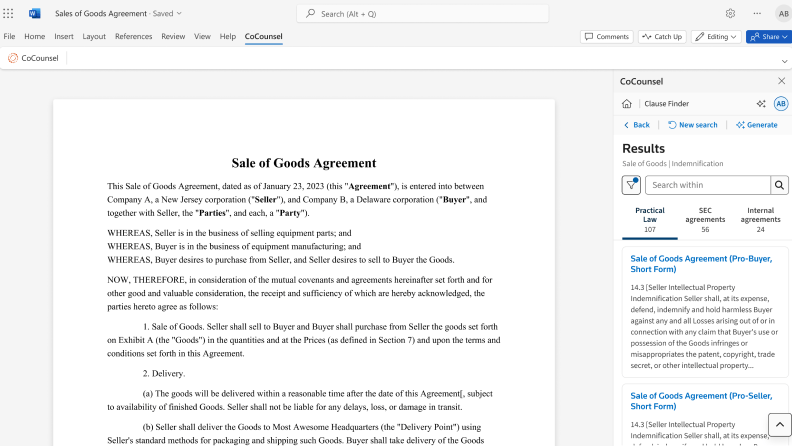
One thing a lawyer should ask, right at the start: “Where is the content from this GenAI system derived from?” Because any GenAI system is only as good as the information on which it was trained, along with the databases that it’s able to access.
This is why having a system with legitimate, secure links to established resources like Practical Law is superior to a GenAI system that’s only been trained on general internet sources like Wikipedia, or one which has harvested data and information in scattershot fashion without copyright owners’ permission — a move that could have troubling legal implications.
What are the tool’s levels of accuracy, and how does it mitigate errors?
Legal professionals are rightfully wary of GenAI “hallucinations,” a term for inaccurate and sometimes nonsensical responses to queries and prompts. The last thing that a lawyer wants to do is present a client with a draft filled with errors and garble.
One way to reduce the chances of encountering hallucinations is for users to ensure their AI tool uses a retrieval-augmented generation (RAG) approach, which offers better guarantees that a query response will be based on only verified data. A robust means of detecting and mitigating factual or usage errors in the draft is also essential.
What are the tool’s levels of security?
The AI tool should have the most up-to-date and advanced data security controls on the market. Questions to ask include where the system’s data servers are located and what measures are taken to secure them, as well as whether the API being used has zero data retention or another set of parameters (such as all AI inputs and outputs being deleted after 30 days).
Building the business case for AI tools
Making a firm-wide commitment to introducing GenAI tools into a firm’s legal operations will require some internal adjustment. But the potential return on investment (ROI) could make the difference between a law firm that’s growing its client base, and one watching its clients diminish.
First, note any tangible benefits. Consider the potential for reduced write-downs on invoices, for example. In-house law departments could earn a bigger budget should they demonstrate they can handle tasks which once had to be outsourced.
Then there are the various intangible benefits. GenAI could spur more efficient onboarding of new associates. Reducing errors and drafting time means that your firm can respond to clients’ needs faster, and with greater reliability.
You’ll need to make the case for moving to GenAI systems to a variety of stakeholders within your company. Each stakeholder set will have its unique concerns, so keep the conversation focused on what’s specifically of interest to them.
For instance, the firm’s finance department will want the ROI laid out. They’ll want a concrete sense of what the expected payback is and when to expect it. Clients and business partners will want to learn about the levels of security and be assured their private data won’t be used to train an AI tool without their permission. Legal operations are going to want to lift the hood on the tool and see how it will be integrated into the larger tech stack, and how scalable it is.
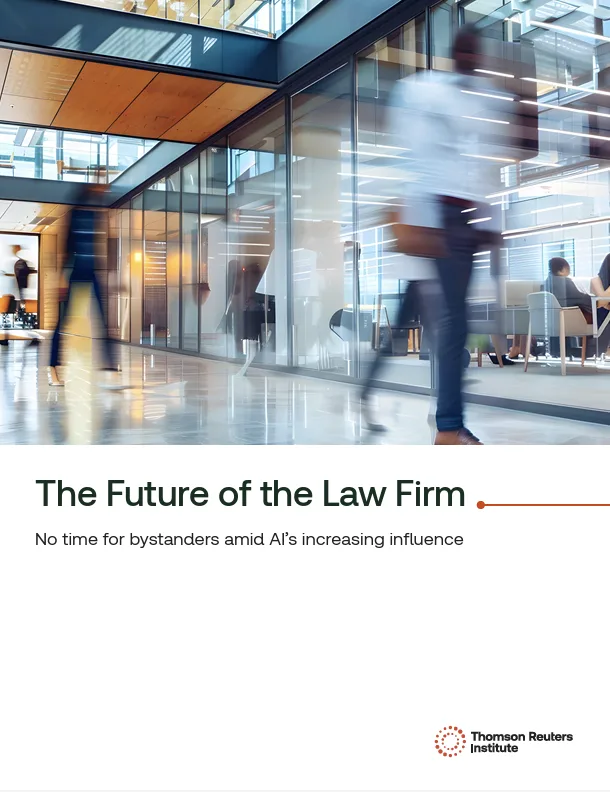
White paper
The future of the law firm: No time for bystanders amid AI’s increasing influence
Access white paper ↗Implementing successful change management via GenAI tools
The key stakeholders have been convinced. Management is on board with implementing a major investment in GenAI systems. Now comes the tough part.
It’s one thing to introduce GenAI into a law firm. It’s another to get legal professionals fully on board with using GenAI and doing away with the idea that it is just the latest tech fad. Unaware of its benefits, they may be quite skeptical. That’s why it’s important for lawyers, particularly junior lawyers whose work stands to be most transformed, to know specifically how the tools will help them, as well as what their firm’s goals are in implementation.
Keep an eye on which lawyers have been early adopters of the technology and ask them to provide facts about how their workload has improved. How much faster has their drafting become? What feedback have they gotten from clients? Have there been any measurable increases in client hours due to GenAI usage?
Selecting “AI advocates” within your firm can go a long way towards increasing acceptance and usage of GenAI tools. The most valuable sales pitch that you can give your employees is the testimony of a colleague whose work has measurably improved.
Leveraging AI for superior drafting
By the end of the decade, if not sooner, a law firm will likely struggle to maintain its current level of client activity if it still relies on drafting tools from decades before. By utilizing AI-enabled drafting tools, legal professionals will transform the drafting process — turning it from drudge work to an essential piece of the business.
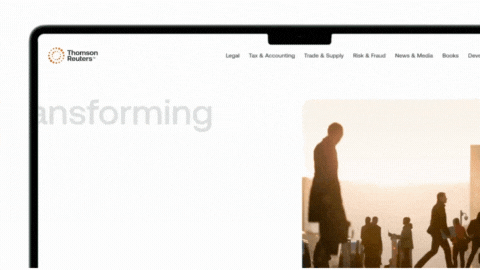
CoCounsel Legal
AI lawyers swear by: Trusted content, expert insights, and an all-in-one solution with ISO/IEC 42001:2023 certification
See it in action ↗








